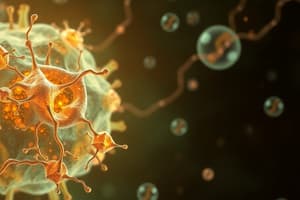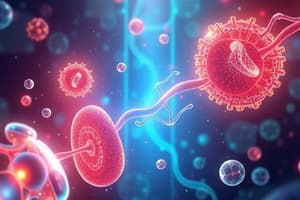Podcast
Questions and Answers
Pharmacokinetics studies what the ______ does to the drug.
Pharmacokinetics studies what the ______ does to the drug.
- receptor
- body (correct)
- disease
- bacteria
Which of the following administration routes has 100% bioavailability?
Which of the following administration routes has 100% bioavailability?
- Intramuscular
- Intravenous (correct)
- Subcutaneous
- Oral
What is the process by which the body chemically modifies a drug called?
What is the process by which the body chemically modifies a drug called?
- Absorption
- Excretion
- Metabolism (correct)
- Distribution
Which of the following describes what the drug does to the body?
Which of the following describes what the drug does to the body?
What is the process of removing a drug from the body called?
What is the process of removing a drug from the body called?
What are drugs that bind to a receptor and activate it called?
What are drugs that bind to a receptor and activate it called?
Which of these is the fraction of an administered dose of a drug that reaches systemic circulation?
Which of these is the fraction of an administered dose of a drug that reaches systemic circulation?
What is the term for a decreased response to a drug with repeated use?
What is the term for a decreased response to a drug with repeated use?
What is the name of the adverse effects on a fetus caused by a drug administered to the mother?
What is the name of the adverse effects on a fetus caused by a drug administered to the mother?
Which phase of clinical trials assesses the safety and tolerability of a drug in healthy volunteers?
Which phase of clinical trials assesses the safety and tolerability of a drug in healthy volunteers?
Flashcards
Pharmacology
Pharmacology
The study of how drugs affect biological systems and vice versa, covering drug sources, effects, and uses.
Pharmacokinetics
Pharmacokinetics
What the body does to the drug, including absorption, distribution, metabolism, and excretion.
Pharmacodynamics
Pharmacodynamics
What the drug does to the body, including its mechanism of action, therapeutic effects, and adverse effects.
Bioavailability
Bioavailability
Signup and view all the flashcards
First-pass metabolism
First-pass metabolism
Signup and view all the flashcards
Prodrugs
Prodrugs
Signup and view all the flashcards
Half-life (t1/2)
Half-life (t1/2)
Signup and view all the flashcards
Agonists
Agonists
Signup and view all the flashcards
Antagonists
Antagonists
Signup and view all the flashcards
Therapeutic Index (TI)
Therapeutic Index (TI)
Signup and view all the flashcards
Study Notes
Pharmacology Overview
- Pharmacology studies the effects of drugs on biological systems and vice versa.
- The discipline includes understanding drug sources, chemical attributes, biological impacts, and how drugs are used therapeutically.
- Drug action mechanisms, interactions, and metabolism fall under pharmacological examination.
- Pharmacology provides a basis for grasping drug development and clinical applications.
Basic Principles
- Pharmacokinetics is how the body affects the drug, including absorption, distribution, metabolism, and excretion.
- Pharmacodynamics is how the drug affects the body, focusing on mechanisms, therapeutic outcomes, and adverse effects.
Pharmacokinetics
- Absorption describes a drug's entry into the bloodstream from the administration site.
- Distribution is a drug's reversible movement from the bloodstream into tissues.
- Metabolism, or biotransformation, is the body's chemical modification of a drug.
- Excretion is the removal of a drug from the body.
Absorption Routes
- Oral administration involves drug absorption from the gastrointestinal tract after swallowing.
- Intravenous (IV) administration introduces drugs directly into a vein, resulting in 100% bioavailability.
- Intramuscular (IM) administration involves injecting drugs into muscle tissue.
- Subcutaneous (SC) administration involves injecting drugs under the skin.
- Inhalation allows drug absorption from the lungs via breathing.
- Transdermal administration delivers drugs into the bloodstream through skin application.
- Bioavailability is the fraction of a drug dose reaching systemic circulation.
- First-pass metabolism is the drug metabolism occurring before systemic circulation, largely in the liver.
Distribution Factors
- Volume of distribution (Vd) reflects the extent of a drug's distribution in the body.
- Plasma protein binding affects drug distribution; only unbound drugs produce effects.
- The blood-brain barrier (BBB) limits the entry of numerous drugs into the brain.
- Tissue binding can extend a drug's duration of action.
Metabolic Processes
- Phase I reactions modify a drug's structure via oxidation, reduction, or hydrolysis.
- Cytochrome P450 (CYP) enzymes are key players in Phase I metabolism.
- Phase II reactions attach polar molecules to drugs to enhance water solubility through conjugation.
- Glucuronidation, sulfation, and acetylation represent typical Phase II reactions.
- Prodrugs need to be metabolized into active forms to exert effects.
- Enzyme induction boosts drug-metabolizing enzyme production or activity.
- Enzyme inhibition reduces drug-metabolizing enzyme activity.
Excretion Mechanisms
- Renal excretion involves the kidneys filtering, secreting, and reabsorbing drugs.
- Glomerular filtration rate (GFR) reflects kidney function and affects drug excretion rates.
- Biliary excretion eliminates drugs via bile.
- Drugs can also be excreted through sweat, saliva, and breast milk.
- Clearance measures the volume of plasma cleared of a drug per unit of time.
- Half-life (t1/2) indicates the time for a drug's plasma concentration to halve.
Pharmacodynamics
- Receptors are drug-binding proteins that mediate drug actions.
- Agonists activate receptors upon binding, triggering a biological response.
- Antagonists block agonists by binding to receptors, preventing biological responses.
- Competitive antagonists reversibly bind to the same site as agonists.
- Non-competitive antagonists bind irreversibly or to a different receptor site.
- Partial agonists elicit submaximal responses, even at full receptor occupancy.
- Inverse agonists produce effects opposite to those of agonists upon receptor binding.
- The dose-response relationship links drug dosage to effect magnitude.
- Efficacy represents the maximum effect a drug can achieve.
- Potency refers to the drug amount needed for a specific effect.
- ED50 is the drug dose that yields 50% of the maximal effect.
- TD50 is the dose at which 50% of the population experiences a toxic effect.
- Therapeutic index (TI) is the TD50/ED50 ratio, indicating drug safety.
- Tolerance is the diminished drug response from repeated use.
- Tachyphylaxis is a rapid decline in drug response after repeated doses.
- Sensitization represents an increased drug response with repeated use.
Drug Interactions
- Pharmacokinetic interactions arise when one drug alters another's absorption, distribution, metabolism, or excretion.
- Pharmacodynamic interactions involve additive, synergistic, or antagonistic effects of drugs on the same target or pathway.
Adverse Drug Reactions
- Side effects are predictable and often unavoidable drug effects.
- Toxic effects are adverse effects from excessive doses or prolonged use.
- Allergic reactions are immune responses to a drug.
- Idiosyncratic reactions are rare, unpredictable adverse effects.
- Teratogenic effects are drug-induced fetal harm during pregnancy.
Drug Development Phases
- Preclinical studies involve in vitro and animal drug testing.
- Phase I clinical trials assess drug safety and tolerability in healthy volunteers.
- Phase II clinical trials gauge drug efficacy in patients with the target illness.
- Phase III clinical trials compare the drug against existing treatments in larger patient groups.
- Phase IV clinical trials are post-market studies monitoring long-term drug safety and efficacy.
Studying That Suits You
Use AI to generate personalized quizzes and flashcards to suit your learning preferences.




